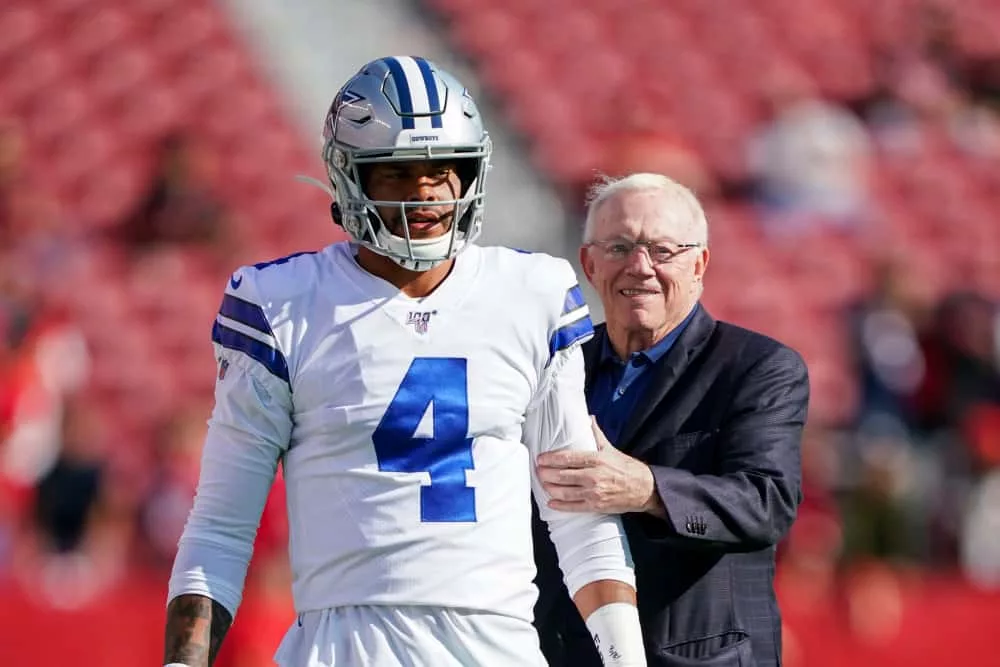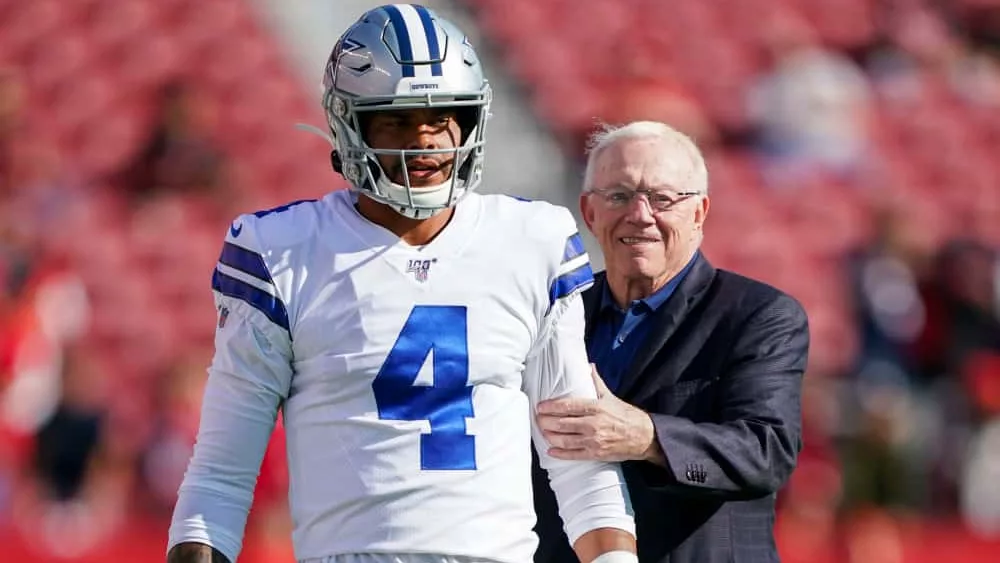
The Dallas Cowboys and Dak Prescott are going to be together for at least one more season, if there is a season. On Sunday it was announced the quarterback, slapped with the franchise tag at the beginning of free agency, will sign his tender on Monday.
This means that the superstar signal caller will call Dallas home for at least one more season at the highest base salary in the league this season, $31.4 million.
A source confirms to @dmn_cowboys that QB Dak Prescott plans on signing his franchise tag of $31.4 million on Monday.
— Calvin Watkins (@calvinwatkins) June 21, 2020
Dak Prescott has officially signed franchise tag.
Breaking News | @LGUS → https://t.co/PNwFhktzd7 pic.twitter.com/i60RvvjKBC
— Dallas Cowboys (@dallascowboys) June 22, 2020
Long-term deal?
Prescott is thought to be seeking a deal that would make him at or near the highest-paid quarterback in the league. He’s reportedly looking for as much or more guaranteed money as what the Los Angeles Rams gave Jared Goff and what the Philadelphia Eagles gave Carson Wentz. Both players were drafted in the same 2016 class that Prescott was in, though as the top two selections, they have earned $40 million and $30 million more, respectively, over their first four years than Prescott, who was taken No. 135 overall.
Goff’s contract included functional guarantees (full guarantees plus year-before guarantees the team wouldn’t walk away from barring a catastrophic event) of $110 million.
Russell Wilson is currently the league’s highest paid quarterback at $35 million average salary. Kansas City’s Patrick Mahomes is currently negotiating his extension which is expected to challenge the $40 million per year average.
According to CBS Sports’ Patrik Walker, the two sides are still planning to work towards that goal of a long-term agreement.
The sticking point is around the length of the agreement. Dallas wants to sign Prescott to their typical long-term deal for stars, of at least five seasons and preferably six or seven seasons. This allows them to spread out cap hits from signing and restructure bonuses (for cap purposes, the money is paid up front but is allocated across five seasons) and get a player for current-day market value when the cost will inevitably skyrocket.
A $35 million average is a lot now, but won’t be in the fifth year of the deal.
Prescott would prefer three years and would take four. This, a similar setup to what Kirk Cousins negotiated with the Minnesota Vikings, would allow the QB to re-enter the market at 30 or 31, soon after the new TV deals are inked (2022). If the NBA set a precedent in their recent deal negotations, NFL salaries are set to skyrocket once those deals come in.
Prescott wisely wants to be eligible to take advantage of that as soon as possible.
Parameters of the tender
Instead, the Cowboys committed to paying Prescott the higher of the three tags, which after the tag window was closed, ended up being the $31.4 million total.
The July 15 deadline is significant, as is the new CBA rule that disallows teams from waiving participation penalties.
When Prescott signs the tender, he is once again an official member of Dallas’ roster. This means that any mandatory attendance event that he skips, will come with a significant daily fine. In year’s past, players who were negotiating long-term contracts and stayed away until a deal was done, would ritually get whatever fines they accrued wiped away by the team.
The new CBA took away that option from the clubs.
In Article 42 (Club Discipline), Section 1 (Maximum Discipline), Subsection vi, it states the following in regards to missing training camp in 2020 or 2021:
Unexcused late reporting for or absence from preseason training camp by a player under contract except those signed as (1) an Unrestricted Free Agent pursuant to Article 9; or (2) a Drafted or Undrafted Rookie pursuant to Article 7—mandatory fine of $50,000 per day. For the avoidance of doubt, any such fines shall be mandatory, and shall not be reduced in amount or waived by the Club, in whole or in part, but must be paid by the player or deducted by the Club as provided in Section 5(b) of this Article. For purposes of this Subsection (vi) and Subsections (vii)-(ix) below, preseason training camp shall be defined as the period beginning with the mandatory reporting date for any player through the Sunday immediately preceding the first game of the NFL regular season.
These rules apply to veteran contracts. Rookie-deal players still get the $40,000 a day fine. Fine levels go up in the 2026 season, according to Exhibit A. There are smaller fine levels for missing mandatory minicamps, though those increased from the previous CBA as well.
Why Dak’s not losing leverage
That’s not necessarily the case.
With the uncertainty over what the season will look like, the NFL could be seeing a huge decrease in ticket and concession sales based on how many fans are actually allowed into stadiums this fall.
There is a possibility that, despite the majority of revenue coming from TV deals, that bottom lines will be heavily impacted and the league could end up either reducing future salary caps or, more likely, borrowing from future caps.
That means the cap may go down, or at a minimum stay flat in order to spread out the hit.
If the Cowboys are forced to tag Prescott again next season, that comes with an 120% increase over this year’s number.
A franchise tag for Prescott means $37.7 million salary in 2021. That’s 19% of the team’s cap.
Right now, not including any remaining cap space the Cowboys would look to rollover from 2020, Dallas has $181 million of salary on the books for 2021, without any Prescott money.
A $37.7 million cap hit in 2021 would force Dallas to release or restructure several players.
That’s his leverage right there.
What this all means for 2020
While offensive coordinator Kellen Moore remains in place to be the voice in Prescott’s ear, and McCarthy is fitting his scheme to meet the verbiage Prescott is familiar with, McCarthy is a West Coast offense guy. That’s wholly different from the system Moore ran under Jason Garrett, an evolution of the Air Coryell vertical progression attack.
The WCO focuses on a horizontal hierarchy and will take some getting used to. Dallas is behind other teams who are working with the same systems from prior years, as the pandemic has completely changed offseason preparations. The longer Prescott is out of the loop, the less fruitful 2020 could be.
Now, he’ll be in tow and in communication with not just McCarthy, but new QB coach Doug Nussmeier who replaced Jon Kitna. Nussmeier was the team’s TE coach the last two seasons.
Prescott has been working out with Kitna, who has been properly credited for many of the mechanical advancements made in 2020, through the offseason.
—COWBOYSWIRE






